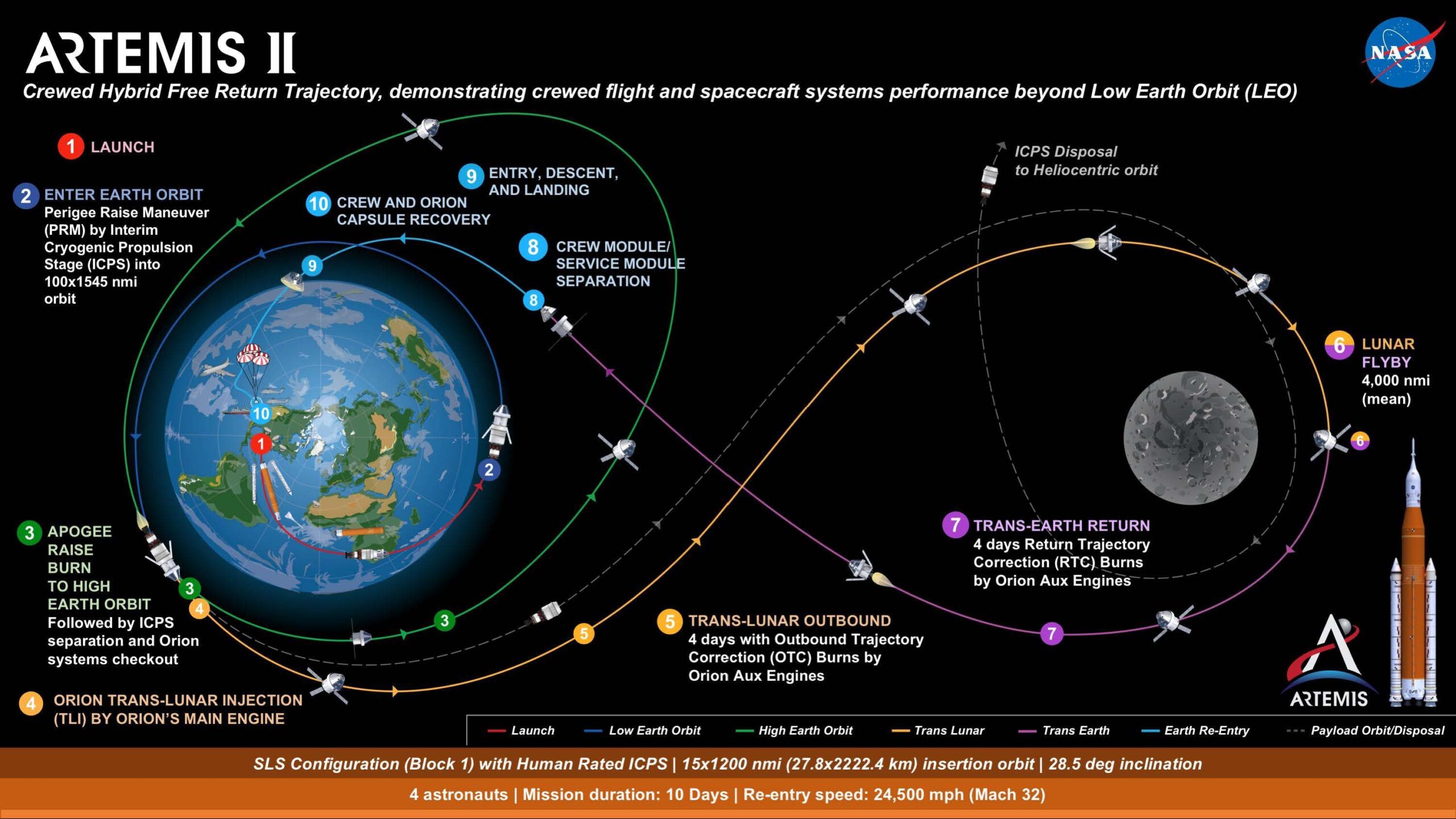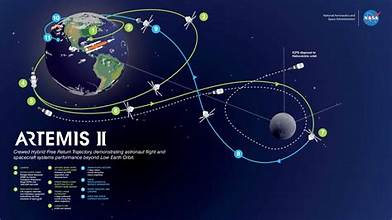
NASA’s Artemis program marks a new era in lunar exploration, with Artemis 2 being a pivotal mission. Scheduled for a 2024 launch, Artemis 2 aims to further humanity’s presence in space and pave the way for sustainable exploration and potential colonization of the Moon. This mission follows Artemis 1, an uncrewed test flight, and is set to be the first crewed mission to the Moon since Apollo 17 in 1972.
Mission Objectives
Artemis 2 has several key objectives:
- Crewed Lunar Flyby: Unlike its predecessor, Artemis 1, Artemis 2 will carry astronauts on a flyby of the Moon, reaching a distance of approximately 7,400 kilometers from the lunar surface. This mission will test life support systems and other technologies essential for long-duration human spaceflight.
- Testing the Orion Spacecraft: The mission will thoroughly test the Orion spacecraft’s systems in a real space environment, ensuring they are ready for future missions. Orion will carry four astronauts and will be launched atop the Space Launch System (SLS), NASA’s most powerful rocket.
- Scientific Research: The crew will conduct experiments and collect data to improve our understanding of the Moon and its environment. This research is crucial for future missions, including those aimed at establishing a sustainable human presence on the Moon.
- International Collaboration: Artemis 2 will showcase international cooperation in space exploration. NASA has partnered with several space agencies, including the European Space Agency (ESA), which contributes the Orion Service Module.
The Crew
The crew of Artemis 2 will consist of four astronauts, including one from a partner space agency. These astronauts are being trained for various scenarios they might encounter during the mission, including spacewalks, system repairs, and emergency procedures. The selection of a diverse crew underscores NASA’s commitment to inclusivity in space exploration.
Technological Innovations
Artemis 2 will leverage several technological innovations:
- Orion Spacecraft: Equipped with advanced life support, communication, and navigation systems, Orion is designed to keep astronauts safe and healthy during their journey to and from the Moon.
- Space Launch System (SLS): As the most powerful rocket ever built, the SLS will provide the necessary thrust to send the Orion spacecraft and its crew to the Moon.
- Deep Space Network: NASA’s upgraded Deep Space Network will facilitate reliable communication between the spacecraft and mission control, ensuring continuous contact throughout the mission.
Challenges and Solutions
Artemis 2 faces numerous challenges, from the harsh conditions of space to the complexities of human spaceflight. Key challenges include:
- Radiation Exposure: Space radiation poses a significant risk to astronauts. The Orion spacecraft is equipped with radiation shielding, and the mission duration is designed to minimize exposure.
- Life Support Systems: Ensuring a safe and habitable environment for the crew is paramount. The mission will test advanced life support systems, including water and air purification, waste management, and temperature control.
- Communication Delays: The vast distance between Earth and the Moon can cause communication delays. The Deep Space Network and autonomous navigation systems on Orion will help mitigate these delays.
Impact and Future Missions
Artemis 2 is a stepping stone to more ambitious missions, including Artemis 3, which aims to land astronauts on the Moon’s surface. The data and experience gained from Artemis 2 will be instrumental in developing the technologies and strategies needed for sustainable lunar exploration and eventual human missions to Mars.
Economic and Scientific Benefits
- Economic Growth: The Artemis program is expected to drive economic growth by fostering innovation and creating high-tech jobs. The development of new technologies for space exploration has numerous applications on Earth, from medical advancements to improved materials and manufacturing processes.
- Scientific Discovery: Artemis 2 will contribute to our understanding of the Moon, providing insights into its geology, resources, and potential for supporting human life. This knowledge is essential for future exploration and the development of lunar habitats.
Conclusion
Artemis 2 represents a significant milestone in NASA’s efforts to return humans to the Moon. By testing critical technologies and systems, conducting scientific research, and fostering international collaboration, the mission will lay the groundwork for a new era of lunar exploration. As we look to the future, Artemis 2 brings us one step closer to the sustainable exploration of the Moon and beyond, opening up new possibilities for humanity in the final frontier.
4o









